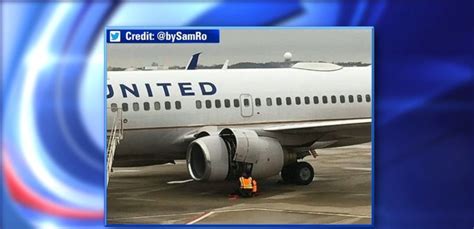
A United Airlines flight traveling from Rome to Chicago declared an emergency and issued an SOS signal over the Atlantic Ocean after approximately eight hours in the air, diverting to Shannon Airport in Ireland. United Airlines confirmed the incident, stating that Flight UA971, a Boeing 787-8, experienced a “potential mechanical issue” prompting the diversion out of an abundance of caution.
The flight, carrying 207 passengers and 13 crew members, landed safely at Shannon Airport at approximately 3:33 p.m. local time (10:33 a.m. ET). Emergency services were on standby as the aircraft made its approach and landing. Following the safe landing, passengers disembarked and were provided with accommodation and further travel arrangements.
“United flight UA971 from Rome to Chicago diverted to Shannon Airport in Ireland this afternoon following a potential mechanical issue,” a United Airlines spokesperson said in a statement. “The flight landed safely, and passengers have deplaned and are being assisted by our team in Shannon. We are providing accommodation and onward travel arrangements for customers.”
The specific nature of the “potential mechanical issue” has not been disclosed by United Airlines, and investigations are underway to determine the exact cause. Aviation experts suggest that an SOS signal, or distress call, is typically issued when an aircraft faces an immediate and significant threat that could endanger the safety of the flight and its occupants.
The diversion of UA971 highlights the stringent safety protocols followed by airlines and the rapid response capabilities in place to address in-flight emergencies. The successful diversion to Shannon Airport underscores the importance of well-trained flight crews and ground support teams in mitigating potential risks and ensuring passenger safety.
While details regarding the mechanical issue remain scarce, the incident serves as a reminder of the complexities and potential hazards associated with air travel and the critical role of preventative maintenance and robust safety measures. Passengers have been re-accommodated on alternative flights to Chicago, and United Airlines is working to minimize disruptions to their travel plans.
The incident is under review by both United Airlines’ internal safety team and relevant aviation authorities to determine the root cause of the mechanical issue and implement any necessary corrective actions. The flight data recorder (FDR) and cockpit voice recorder (CVR) will likely be analyzed as part of the investigation to provide a comprehensive understanding of the events leading up to the emergency declaration.
Expanded Details and Context
The decision to declare an emergency and divert a transatlantic flight is a serious one, typically made when the flight crew assesses that a situation poses an immediate threat to the safety of the aircraft and its occupants. Several factors could lead to such a decision, ranging from engine failure to severe turbulence or critical system malfunctions. The declaration of an SOS signal, specifically, indicates a higher level of urgency, suggesting that the crew believes the aircraft is in imminent danger.
Shannon Airport, located on the west coast of Ireland, is a common diversion point for transatlantic flights experiencing emergencies. Its strategic location, long runway, and experienced air traffic control team make it well-suited for handling unscheduled landings. The airport has a long history of accommodating emergency diversions, often due to its proximity to major air routes between North America and Europe.
In situations like this, the flight crew follows established procedures that prioritize the safety of the passengers and crew. This includes communicating with air traffic control to coordinate the diversion, preparing the cabin for a potential emergency landing, and providing updates to passengers to keep them informed and reassured. Emergency services, including fire trucks and ambulances, are typically dispatched to the airport to be on standby in case they are needed.
The Boeing 787-8, the aircraft type involved in the incident, is a modern, fuel-efficient wide-body airliner that is widely used for long-haul flights. It incorporates advanced technologies, such as composite materials and improved engine design, to enhance performance and reduce environmental impact. However, like all aircraft, the 787-8 is subject to regular maintenance checks and inspections to ensure its continued airworthiness.
The investigation into the “potential mechanical issue” will likely involve a thorough examination of the aircraft’s systems, including the engines, hydraulics, avionics, and flight controls. Engineers will analyze data from the flight data recorder and cockpit voice recorder to reconstruct the events leading up to the emergency declaration. The investigation will also consider factors such as weather conditions, maintenance history, and crew performance.
The findings of the investigation will be used to identify the root cause of the mechanical issue and to recommend any necessary corrective actions. These actions could include changes to maintenance procedures, modifications to the aircraft’s design, or revisions to crew training programs. The goal is to prevent similar incidents from occurring in the future and to enhance the safety of air travel.
The diversion of UA971 serves as a reminder of the importance of safety in the aviation industry. Airlines invest significant resources in maintenance, training, and safety management systems to minimize the risk of accidents and incidents. These efforts are supported by regulatory agencies, such as the Federal Aviation Administration (FAA) in the United States and the European Aviation Safety Agency (EASA) in Europe, which set safety standards and oversee airline operations.
While air travel is generally considered to be very safe, incidents like the diversion of UA971 can raise concerns among passengers. It is important to remember that airlines have a strong incentive to prioritize safety, as any accident or incident can have serious consequences for their reputation and financial performance. Airlines also work closely with aircraft manufacturers and regulatory agencies to ensure that their aircraft are properly maintained and operated.
The incident also highlights the challenges of managing long-haul flights over vast stretches of ocean. In the event of an emergency, flight crews must make quick decisions based on the available information and coordinate with air traffic control to find the nearest suitable airport. This requires a high level of skill and training, as well as effective communication and teamwork.
Passengers who were on board UA971 have been provided with accommodation and onward travel arrangements. United Airlines is working to minimize the disruption to their travel plans and to ensure that they reach their final destinations as soon as possible. The airline is also providing updates to passengers and their families to keep them informed of the latest developments.
The long-term impact of the incident on United Airlines’ operations is likely to be minimal. The airline has a strong safety record and a well-established reputation for reliability. However, the incident may prompt a review of its maintenance procedures and safety protocols to ensure that they are up to date and effective.
The aviation industry as a whole is constantly learning and evolving to improve safety. Incidents like the diversion of UA971 provide valuable lessons that can be used to enhance safety measures and prevent future accidents. The investigation into the incident will undoubtedly contribute to this ongoing process of improvement.
In the meantime, passengers can take comfort in the fact that airlines are committed to safety and that they are constantly working to minimize the risks associated with air travel. By following the instructions of the flight crew and being aware of their surroundings, passengers can help to ensure a safe and enjoyable flight. The successful landing in Shannon and the safe disembarkation of all passengers and crew demonstrate the effectiveness of these safety measures. The incident underscores the layers of redundancy and the high level of preparedness that characterize modern aviation.
The declaration of an SOS is relatively rare in modern commercial aviation, given the advancements in aircraft reliability and navigational technology. However, it remains a crucial tool for flight crews to signal distress and request immediate assistance when faced with a critical situation. The specific criteria for declaring an SOS can vary depending on the airline and the regulatory authority, but it typically involves a situation where the aircraft is in imminent danger and requires urgent intervention. This could include a loss of engine power, a fire on board, a rapid decompression, or a structural failure. The decision to declare an SOS is ultimately up to the captain of the aircraft, who must weigh the risks and benefits of the action and act in the best interests of the safety of the passengers and crew.
The role of air traffic control (ATC) in handling emergency situations is also critical. ATC provides guidance and support to the flight crew, helping them to navigate to the nearest suitable airport and coordinating with emergency services on the ground. ATC also monitors the aircraft’s position and altitude, and can provide assistance in the event of a loss of communication or navigation. In the case of UA971, Shannon ATC played a key role in facilitating the safe landing of the aircraft.
Specific Potential Scenarios Leading to the SOS Declaration
While the airline has only cited a “potential mechanical issue,” several scenarios could have led the crew to declare an emergency and issue an SOS. These include:
- Engine Failure: A sudden and unrecoverable failure of one of the aircraft’s engines would be a major concern, especially over the ocean.
- Hydraulic System Failure: Loss of hydraulic pressure could impair the aircraft’s control surfaces, making it difficult to steer and maintain altitude.
- Electrical System Failure: A major electrical failure could disable critical systems, including navigation and communication equipment.
- Fire Onboard: A fire in the cabin or cargo hold would pose an immediate threat to the safety of the passengers and crew.
- Rapid Decompression: A sudden loss of cabin pressure could lead to hypoxia and other health problems for the occupants.
- Structural Damage: Discovery of significant structural damage to the aircraft’s wings or fuselage would be a serious concern.
It is important to note that these are just a few possible scenarios, and the actual cause of the emergency declaration may be something else entirely. The investigation will seek to determine the precise nature of the mechanical issue and the factors that led the crew to declare an emergency.
The Passenger Experience During a Diversion
For passengers on board a flight that is diverted due to an emergency, the experience can be stressful and unsettling. The sudden change of plans, the uncertainty about the nature of the problem, and the potential for delays can all contribute to anxiety. Airlines typically try to keep passengers informed as much as possible, but the information may be limited in the early stages of an emergency. Passengers may also experience discomfort due to turbulence or changes in cabin pressure.
After landing at the diversion airport, passengers are typically deplaned and taken to a holding area or terminal. They may be provided with food, water, and other amenities. The airline will then work to re-accommodate passengers on alternative flights to their final destinations. This can be a complex process, especially when dealing with a large number of passengers and limited flight availability. Passengers may also be entitled to compensation for the delays and inconvenience caused by the diversion, depending on the airline’s policies and applicable regulations.
The United Airlines team in Shannon provided assistance to the passengers, including accommodation and onward travel arrangements. This is a standard procedure for airlines when flights are diverted, and it is designed to minimize the disruption to passengers’ travel plans. The airline will also work to communicate with passengers’ families and keep them informed of the latest developments.
Impact on Future Flights and Operations
Following the diversion, the aircraft will undergo thorough maintenance and inspection before it is returned to service. United Airlines will also review its maintenance procedures and safety protocols to identify any areas for improvement. The incident may also have an impact on future flights and operations, as the airline may need to adjust its schedules or routes to account for the aircraft being out of service.
The long-term impact of the incident on United Airlines’ reputation is likely to be minimal, as long as the airline handles the situation transparently and effectively. Passengers are generally understanding of unforeseen events, such as mechanical problems, and they appreciate airlines that prioritize safety. However, if the investigation reveals any negligence or wrongdoing on the part of the airline, it could face legal action and damage to its reputation.
The aviation industry as a whole is constantly learning and evolving to improve safety. Incidents like the diversion of UA971 provide valuable lessons that can be used to enhance safety measures and prevent future accidents. The investigation into the incident will undoubtedly contribute to this ongoing process of improvement.
Technological Aspects and Modern Aircraft Safety
Modern aircraft, like the Boeing 787-8, are equipped with sophisticated monitoring and diagnostic systems that can detect potential problems before they become critical. These systems can provide real-time data on the performance of the aircraft’s engines, hydraulics, avionics, and other systems. This data is transmitted to the flight crew and to ground-based maintenance teams, allowing them to identify and address potential problems proactively.
In addition, modern aircraft are designed with multiple layers of redundancy to ensure that critical systems remain operational even in the event of a failure. For example, the Boeing 787-8 has multiple hydraulic systems, electrical systems, and flight control systems. This redundancy helps to prevent a single point of failure from causing a catastrophic accident.
The use of advanced materials, such as composites, also contributes to the safety of modern aircraft. Composites are stronger and lighter than traditional aluminum alloys, which allows for more efficient designs and reduces the risk of structural failure.
International Regulations and Cooperation
The safety of air travel is governed by a complex web of international regulations and agreements. The International Civil Aviation Organization (ICAO) sets global standards for aviation safety, and individual countries are responsible for implementing these standards within their own jurisdictions.
Airlines that operate international flights must comply with the safety regulations of both their home country and the countries they fly to. This can involve a significant amount of paperwork and coordination, but it is essential for ensuring the safety of passengers and crew.
International cooperation is also crucial for investigating accidents and incidents. When an accident occurs in international airspace, the country where the aircraft is registered typically takes the lead in the investigation, but other countries may also participate. This cooperation helps to ensure that all relevant information is gathered and that the investigation is conducted fairly and impartially.
Future of Aviation Safety
The aviation industry is constantly evolving, and new technologies and procedures are being developed to improve safety. Some of the key trends in aviation safety include:
- Enhanced Automation: Automation is playing an increasingly important role in aviation safety, with automated systems now capable of performing many tasks that were previously done by humans. This can help to reduce pilot workload and improve decision-making.
- Data Analytics: The aviation industry is generating vast amounts of data, and data analytics is being used to identify patterns and trends that can help to improve safety. For example, data analytics can be used to identify high-risk areas for bird strikes or to predict when aircraft components are likely to fail.
- Advanced Training: Pilot training is becoming increasingly sophisticated, with simulators now able to replicate a wide range of real-world scenarios. This allows pilots to practice their skills in a safe and controlled environment.
- Improved Communication: Communication between pilots, air traffic controllers, and ground-based maintenance teams is becoming more seamless, thanks to advances in technology. This can help to improve coordination and reduce the risk of misunderstandings.
These trends suggest that the future of aviation safety is bright. By continuing to invest in new technologies and procedures, the aviation industry can make air travel even safer and more reliable. The incident involving United Airlines Flight UA971 underscores the need for continued vigilance and the importance of maintaining high standards of safety in all aspects of aviation operations.
The safe landing of the aircraft in Shannon is a testament to the professionalism and expertise of the flight crew, the air traffic controllers, and the ground-based support teams. It is also a reminder that even in the face of unexpected challenges, the aviation industry is committed to ensuring the safety of passengers and crew.
Frequently Asked Questions (FAQ)
-
What was the reason for the United Airlines flight UA971 declaring an emergency?
- United Airlines stated that the flight diverted due to a “potential mechanical issue.” The specific nature of the issue has not been publicly disclosed, and an investigation is underway to determine the exact cause.
-
Where did the flight divert to after declaring the emergency?
- The flight diverted to Shannon Airport in Ireland. Shannon Airport is a common diversion point for transatlantic flights due to its strategic location and long runway.
-
How many passengers and crew members were on board the flight?
- There were 207 passengers and 13 crew members on board the United Airlines flight UA971.
-
What type of aircraft was involved in the incident?
- The aircraft involved was a Boeing 787-8.
-
What assistance was provided to passengers after the diversion?
- United Airlines provided accommodation and onward travel arrangements for the passengers in Shannon. They were also assisted by the United Airlines team in Shannon.









